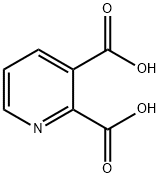
2,3-пиридиндикарбоновая кислота
- английское имяQuinolinic acid
- CAS №89-00-9
- CBNumberCB7316162
- ФормулаC7H5NO4
- мольный вес167.12
- EINECS201-874-8
- номер MDLMFCD00006295
- файл Mol89-00-9.mol
| Температура плавления | 188-190 °C (dec.) (lit.) |
| Температура кипения | 295.67°C (rough estimate) |
| плотность | 1.5216 (rough estimate) |
| показатель преломления | 1.6280 (estimate) |
| температура хранения | Keep in dark place,Sealed in dry,Room Temperature |
| растворимость | 10g/l |
| форма | Crystalline Powder |
| пка | 2.43(at 25℃) |
| цвет | White to light yellow-beige |
| Запах | odorless |
| Растворимость в воде | 0.55 g/100 mL |
| Мерк | 14,8073 |
| БРН | 137110 |
| ИнЧИКей | GJAWHXHKYYXBSV-UHFFFAOYSA-N |
| Справочник по базе данных CAS | 89-00-9(CAS DataBase Reference) |
| Рейтинг продуктов питания EWG | 1 |
| FDA UNII | F6F0HK1URN |
| Система регистрации веществ EPA | 2,3-Pyridinedicarboxylic acid (89-00-9) |
| UNSPSC Code | 12352100 |
| NACRES | NA.22 |
| Коды опасности | Xi | |||||||||
| Заявления о рисках | 36/37/38-33 | |||||||||
| Заявления о безопасности | 26-36/37-24/25-37 | |||||||||
| WGK Германия | 3 | |||||||||
| RTECS | US7967250 | |||||||||
| TSCA | T | |||||||||
| Класс опасности | IRRITANT | |||||||||
| кода HS | 29333999 | |||||||||
| Банк данных об опасных веществах | 89-00-9(Hazardous Substances Data) | |||||||||
| Токсичность | Focal injection of quinolinic acid into specific areas of the brain produces neuronal damage although sparing axons of passage. Similarities between the biochemical and morphological profiles of these lesions and human neuropathy seen in neurodegenerative diseases have led to the proposal that endogenous excitotoxins may play a role in such neurodegenerative disease states. Quinolinic acid is an intermediate in the kynurenine pathway of tryptophan metabolism and has been detected in the brains of several mammals including man. The neuroexcitatory action is thought to be mediated via interaction with the N-methyl-D-aspartate (NMDA) receptor of the glutamate family. No mechanism for quinolinic acid removal, nor for synaptic inactivation, has been found, and consequently accumulation of concentrations capa_x0002_ble of inducing neuronal degeneration and death may occur. | |||||||||
| NFPA 704: |
|
рисовальное письмо(GHS)
-
рисовальное письмо(GHS)

-
сигнальный язык
предупреждение
-
вредная бумага
H319:При попадании в глаза вызывает выраженное раздражение.
H335:Может вызывать раздражение верхних дыхательных путей.
-
оператор предупредительных мер
P261:Избегать вдыхания пыли/ дыма/ газа/ тумана/ паров/ аэрозолей.
P264:После работы тщательно вымыть кожу.
P271:Использовать только на открытом воздухе или в хорошо вентилируемом помещении.
P280:Использовать перчатки/ средства защиты глаз/ лица.
P304+P340+P312:ПРИ ВДЫХАНИИ: Свежий воздух, покой. Обратиться за медицинской помощью при плохом самочувствии.
P305+P351+P338:ПРИ ПОПАДАНИИ В ГЛАЗА: Осторожно промыть глаза водой в течение нескольких минут. Снять контактные линзы, если Вы ими пользуетесь и если это легко сделать. Продолжить промывание глаз.
2,3-пиридиндикарбоновая кислота химические свойства, назначение, производство
Химические свойства
White powder;Light yellow powderИспользование
Quinolinic acid is an endogenous NMDA agonist. Quinolinic acid is a metabolite of tryptophan that acts as a putative NMDA receptor agonist. Quinolinic acid is an ?excitotoxic? metabolite and an agonist of N-methyl-D-aspartate receptors. properties of KYNA raise the possibility of a functional link between KYNA and QUIN in the brain which may be of relevance for an understanding of human neurodegenerative disorders. Quinolinic acid is a potent endogenous excitant at amino acid receptors in CNS.Биосинтез
The 3-hydroxyanthranilic acid oxygenase (3-HAO) catalyzes the conversion of 3-hydroxyanthranilic acid (3-HA) acid to an unstable intermediate, aminocarboxymuconic semialdehyde, which then preferentially converts to QUIN by a nonenzymatic cyclisation. This intermediate compound can also produce picolinic acid instead of QUIN. Finally, QUIN is catabolized to NAD+ and carbon dioxide by the action of quinolinate phosphoribosyl transferase (QPRT). This enzyme has been identified in rat and human CNS tissue[1].Опасность
A poison by skin contact. Moderately toxic by ingestion. A mild skin irritant.Промышленное использование
The use of quinolinic acid during flotation of hematite results in the adsorption of quinoline on hematite, allowing amine to selectively adsorb onto the hematite surface.Биологическая активность
Endogenous NMDA agonist and transmitter candidate. May distinguish between NMDA receptor subtypes.Профиль безопасности
A poison by skin contact. Moderately toxic by ingestion. Experimental reproductive effects. A mdd skinn irritant. When heated to decomposition it emits toxic vapors of NOx.2,3-пиридиндикарбоновая кислота запасные части и сырье
сырьё
- Калия перманганат
- KZESTKDHUUMSOC-UHFFFAOYSA-N
- Соль меди (II) 2,3-пиридиндикарбоновой кислоты
- Диэтилпиридин-2,3-дикарбоксилат
- 5-БРОМО-8-НИТРОХИНОЛИН
1of4
запасной предмет
- 3-TERT-BUTOXYCARBONYLAMINO-PYRIDINE-2-CARBOXYLIC ACID
- METHYL 3-CYANOPYRIDINE-2-CARBOXYLATE
- 3-аминопиридин-2-карбоновая кислота
- 5-Methylpyridine-2,3-dicarboxylic acid
- 3-КАРБАМОИЛПИКОЛИНОВАЯ КИСЛОТА
1of3
2,3-пиридиндикарбоновая кислота поставщик
| поставщик | телефон | страна | номенклатура продукции | благоприятные условия | |
|---|---|---|---|---|---|
| +86-533-2119995 +8615053330977 |
China | 37 | 58 | ||
| +8615531157085 | China | 8804 | 58 | ||
| +86 13288715578 +8613288715578 |
China | 12825 | 58 | ||
| +86-13131129325 | China | 5887 | 58 | ||
| +8613343047651 | China | 3692 | 58 | ||
| +8615373025980 | China | 895 | 58 | ||
| +8615350851019 | China | 1001 | 58 | ||
| +86 (576) 8169-6106 | China | 880 | 50 | ||
| +86-(0)57185586718 +86-13336195806 |
China | 29792 | 60 | ||
| +86-0371-55170693 +86-19937530512 |
China | 21632 | 55 |
2,3-пиридиндикарбоновая кислота Обзор)
- 2,6-лутидин
- 5,6,7,8-Тетрагидроизохинолин
- Диэтиловый эфир 1,4-дигидро-2 ,6-диметилпиридин-3 ,5-дикарбоксила
- Пиридин
- Изохинолин
- Глицин
- Кислота лимонная
- Фолиевая кислота
- Пиридин-2 ,6-дикарбоновой кислоты
- 2,5-пиридиндикарбоновая кислота
1of4